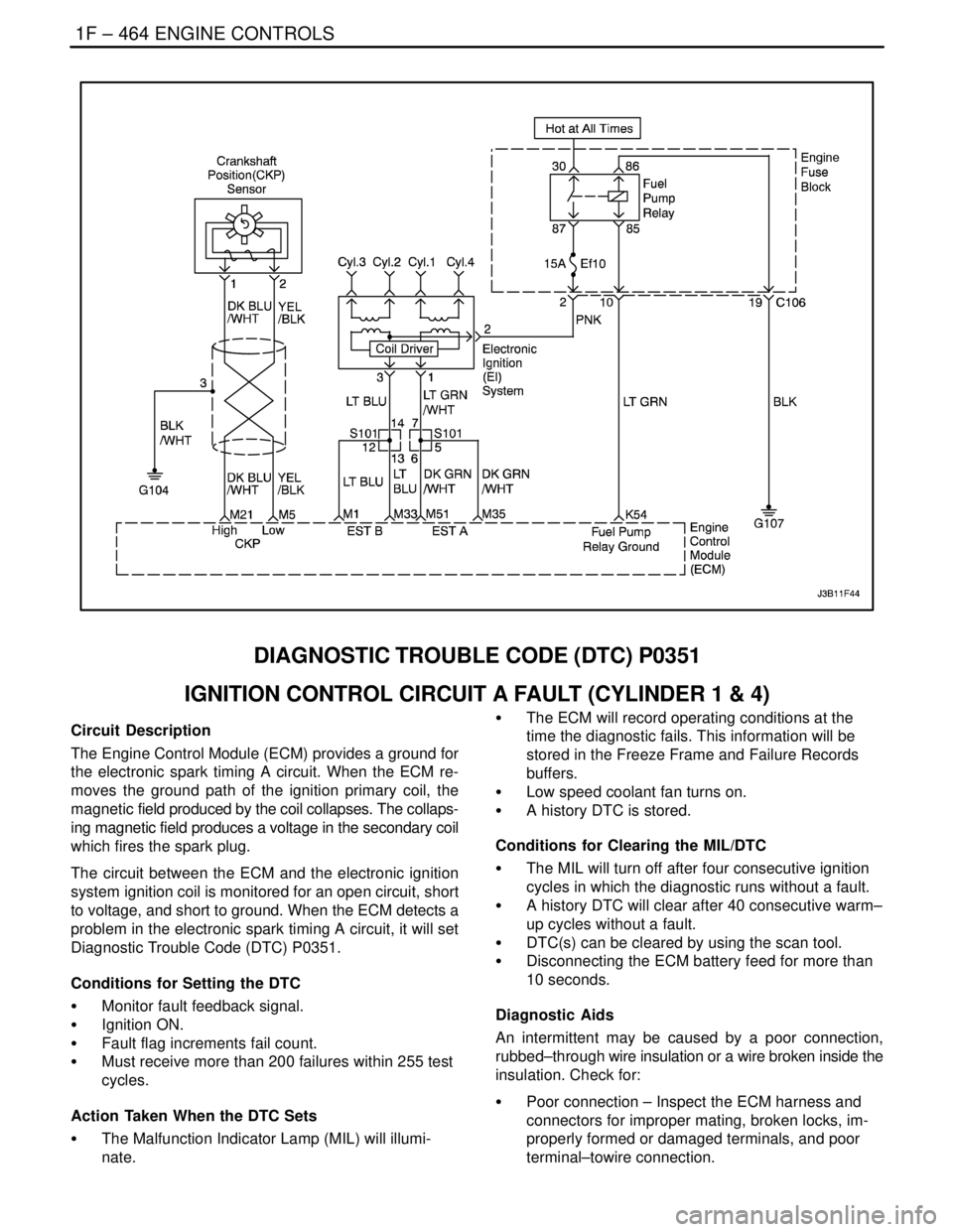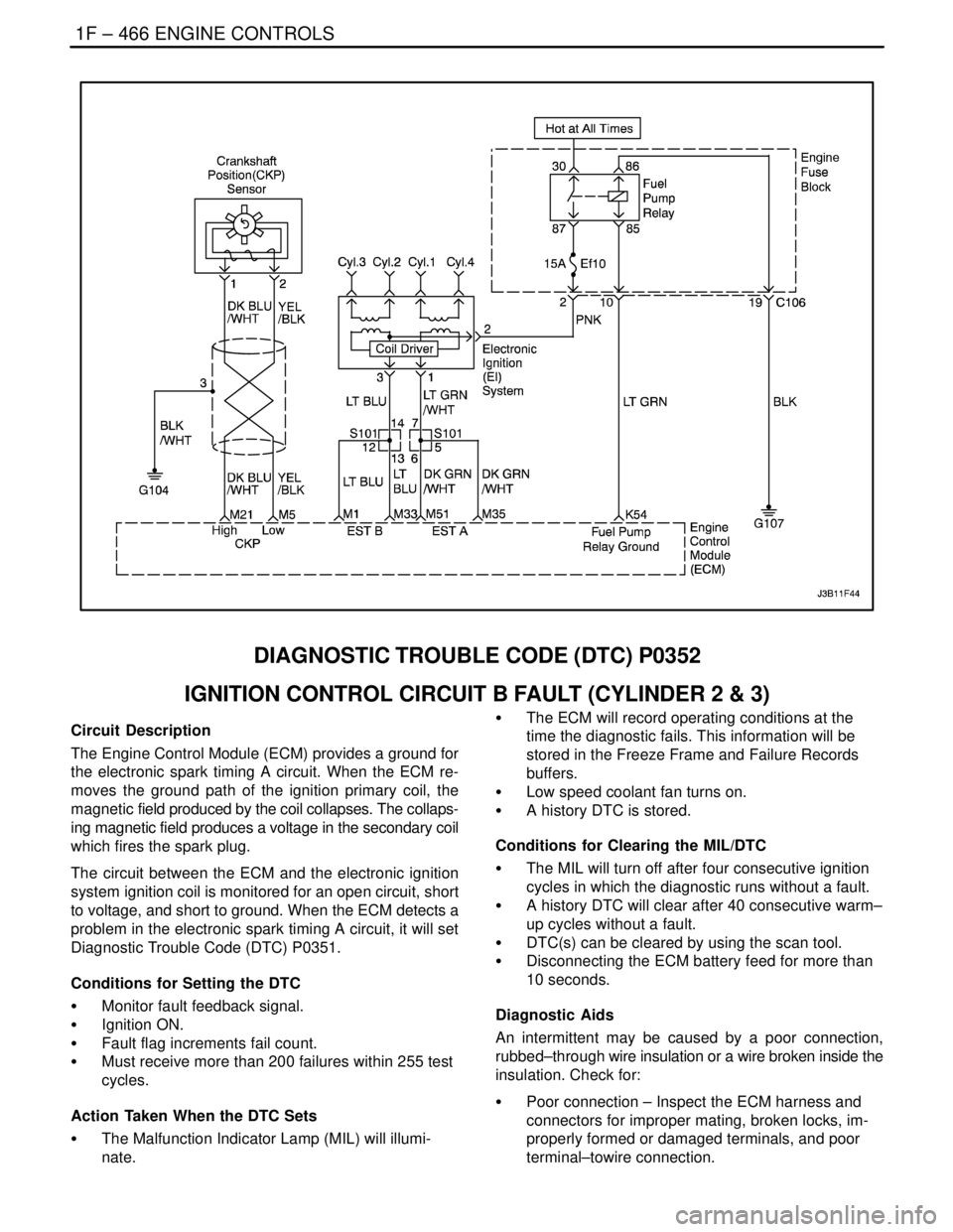2004 DAEWOO LACETTI Lamp
[x] Cancel search: LampPage 710 of 2643

1F – 464IENGINE CONTROLS
DAEWOO V–121 BL4
DIAGNOSTIC TROUBLE CODE (DTC) P0351
IGNITION CONTROL CIRCUIT A FAULT (CYLINDER 1 & 4)
Circuit Description
The Engine Control Module (ECM) provides a ground for
the electronic spark timing A circuit. When the ECM re-
moves the ground path of the ignition primary coil, the
magnetic field produced by the coil collapses. The collaps-
ing magnetic field produces a voltage in the secondary coil
which fires the spark plug.
The circuit between the ECM and the electronic ignition
system ignition coil is monitored for an open circuit, short
to voltage, and short to ground. When the ECM detects a
problem in the electronic spark timing A circuit, it will set
Diagnostic Trouble Code (DTC) P0351.
Conditions for Setting the DTC
S Monitor fault feedback signal.
S Ignition ON.
S Fault flag increments fail count.
S Must receive more than 200 failures within 255 test
cycles.
Action Taken When the DTC Sets
S The Malfunction Indicator Lamp (MIL) will illumi-
nate.S The ECM will record operating conditions at the
time the diagnostic fails. This information will be
stored in the Freeze Frame and Failure Records
buffers.
S Low speed coolant fan turns on.
S A history DTC is stored.
Conditions for Clearing the MIL/DTC
S The MIL will turn off after four consecutive ignition
cycles in which the diagnostic runs without a fault.
S A history DTC will clear after 40 consecutive warm–
up cycles without a fault.
S DTC(s) can be cleared by using the scan tool.
S Disconnecting the ECM battery feed for more than
10 seconds.
Diagnostic Aids
An intermittent may be caused by a poor connection,
rubbed–through wire insulation or a wire broken inside the
insulation. Check for:
S Poor connection – Inspect the ECM harness and
connectors for improper mating, broken locks, im-
properly formed or damaged terminals, and poor
terminal–towire connection.
Page 712 of 2643

1F – 466IENGINE CONTROLS
DAEWOO V–121 BL4
DIAGNOSTIC TROUBLE CODE (DTC) P0352
IGNITION CONTROL CIRCUIT B FAULT (CYLINDER 2 & 3)
Circuit Description
The Engine Control Module (ECM) provides a ground for
the electronic spark timing A circuit. When the ECM re-
moves the ground path of the ignition primary coil, the
magnetic field produced by the coil collapses. The collaps-
ing magnetic field produces a voltage in the secondary coil
which fires the spark plug.
The circuit between the ECM and the electronic ignition
system ignition coil is monitored for an open circuit, short
to voltage, and short to ground. When the ECM detects a
problem in the electronic spark timing A circuit, it will set
Diagnostic Trouble Code (DTC) P0351.
Conditions for Setting the DTC
S Monitor fault feedback signal.
S Ignition ON.
S Fault flag increments fail count.
S Must receive more than 200 failures within 255 test
cycles.
Action Taken When the DTC Sets
S The Malfunction Indicator Lamp (MIL) will illumi-
nate.S The ECM will record operating conditions at the
time the diagnostic fails. This information will be
stored in the Freeze Frame and Failure Records
buffers.
S Low speed coolant fan turns on.
S A history DTC is stored.
Conditions for Clearing the MIL/DTC
S The MIL will turn off after four consecutive ignition
cycles in which the diagnostic runs without a fault.
S A history DTC will clear after 40 consecutive warm–
up cycles without a fault.
S DTC(s) can be cleared by using the scan tool.
S Disconnecting the ECM battery feed for more than
10 seconds.
Diagnostic Aids
An intermittent may be caused by a poor connection,
rubbed–through wire insulation or a wire broken inside the
insulation. Check for:
S Poor connection – Inspect the ECM harness and
connectors for improper mating, broken locks, im-
properly formed or damaged terminals, and poor
terminal–towire connection.
Page 714 of 2643

1F – 468IENGINE CONTROLS
DAEWOO V–121 BL4
DIAGNOSTIC TROUBLE CODE (DTC) P0401
EXHAUST GAS RECIRCULATION INSUFFICIENT FLOW
Circuit Description
An Exhaust Gas Recirculation (EGR) system is used to
lower Nitrogen Oxide (NOx) emission levels caused by
high combustion temperatures. It accomplishes this by
feeding small amounts of exhaust gases back into the
combustion chamber. When the air/fuel mixture is diluted
with the exhaust gases, combustion temperatures are re-
duced
A linear EGR valve is used on this system. The linear EGR
valve is designed to accurately supply exhaust gases to
the engine without the use of intake manifold vacuum. The
valve controls exhaust flow going into the intake manifold
from the exhaust manifold through an orifice with an En-
gine Control Module (ECM) controlled pintle. The ECM
controls the pintle position using inputs from the Throttle
Position (TP) and Manifold Absolute Pressure (MAP) sen-
sors. The ECM then commands the EGR valve to operate
when necessary by controlling an ignition signal through
the ECM. This can be monitored on a scan tool as the De-
sired EGR Position.
The ECM monitors the results of its command through a
feedback signal. By sending a 5 volt reference and a
ground to the EGR valve, a voltage signal representing the
EGR valve pintle position is sent to the ECM. This feed-
back signal can also be monitored on a scan tool and is the
actual position of the EGR pintle. The Actual EGR Position
should always be near the commanded or Desired EGR
Position.
This diagnostic will determine if there is a reduction in EGR
flow.
Conditions for Setting the DTC
S DTCs P0106, P0107, P0108, P0117, P0118,
P0122, P0123, P0201, P0202, P0203, P0204,
P0351, P0352, P0402, P0404, P1404, P0405,
P0406 and P0502 are not set.
S Test in Decel Fuel Cutoff (DFCO) mode.
S Barometric Pressure (BARO) is greater than 72
kPa (10.4 psi).
S Vehicle speed is greater than 18 km/h (11.2
mph).
S A/C clutch/transmission clutch are unchanged.
S Rpm is between 1400 and 3000 for manual
transaxle.
S Rpm is between 1300 and 2900 for automatic
transaxle.
S Compensated MAP is with 10.3 to 32 kpa (1.5 to
4.6 psi) range.
S Start test
S Throttle position (TP) sensor is less then 1%.
S EGR is less than 1%.
S Change in MAP is less than 1.0 kpa (0.15 psi)Note : Test will be aborted when:
S Change in vehicle speed is greater than 5km/h (3.1
mph).
S Rpm is increased more than 75.
S EGR opened less than 90% commanded position.
Action Taken When the DTC Sets
S The Malfunction Indicator Lamp (MIL) will not illumi-
nate.
S The ECM will store conditions which were present
when the DTC set as Failure Records data only.
This information will not be stored in the Freeze
Frame data.
S A history Diagnostic Trouble Code (DTC) is stored.
S EGR is disabled.
Conditions for Clearing the MIL/DTC
S A history DTC will clear after 40 consecutive warm–
up cycles without a fault.
S DTC(s) can be cleared by using the scan tool.
S Disconnecting the ECM battery feed for more than
10 seconds.
Diagnostic Aids
The EGR Decel Filter value can be a great aid in determin-
ing if a problem exists and to verify repairs. The EGR De-
cel Filter is an average of the difference in the expected
MAP change and the actual MAP change caused by open-
ing the EGR valve during a deceleration, and is used to de-
termine when the MIL is illuminated. By driving the vehicle
up to approximately 97 km/h (60 mph) and decelerating to
32 km/h (20 mph), it can be determined if the EGR system
is OK, partially restricted, or fully restricted.
A more negative number (less than –3) indicates that the
system is working normally, whereas a positive number in-
dicates that the system is being restricted and that the ex-
pected amount of EGR flow is was not seen. A number
that falls between negative 3 and positive 2 indicates that
the system is partially restricted but not restricted enough
to cause an emissions impact.
The EGR Decel Filter value should always be at –3 or low-
er. If the EGR Decel Filter number becomes more positive
(towards 0 or more), then the EGR system is becoming re-
stricted. Look for possible damage to the EGR pipe or for
a restriction caused by carbon deposits in the EGR pas-
sages or on the EGR valve.
Test Description
Number(s) below refer to the step number(s) on the Diag-
nostic Table.
1. The On–Board Diagnostic (EOBD) System Check
prompts the technician to complete some basic
checks and store the freeze frame and failure re-
cords data on the scan tool if applicable. This
Page 716 of 2643

1F – 470IENGINE CONTROLS
DAEWOO V–121 BL4
DIAGNOSTIC TROUBLE CODE (DTC) P0402
EXHAUST GAS RECIRCULATION EXCESSIVE FLOW
Circuit Description
An Exhaust Gas Recirculation (EGR) system is used to
lower Nitrogen Oxide (NOx) emission levels caused by
high combustion temperatures. It accomplishes this by
feeding small amounts of exhaust gases back into the
combustion chamber. When the air/fuel mixture is diluted
with the exhaust gases, combustion temperatures are re-
duced
A linear EGR valve is used on this system. The linear EGR
valve is designed to accurately supply exhaust gases to
the engine without the use of intake manifold vacuum. The
valve controls exhaust flow going into the intake manifold
from the exhaust manifold through an orifice with an En-
gine Control Module (ECM) controlled pintle. The ECM
controls the pintle position using inputs from the Throttle
Position (TP) and Manifold Absolute Pressure (MAP) sen-
sors. The ECM then commands the EGR valve to operate
when necessary by controlling an ignition signal through
the ECM. This can be monitored on a scan tool as the De-
sired EGR Position.
The ECM monitors the results of its command through a
feedback signal. By sending a 5 volt reference and a
ground to the EGR valve, a voltage signal representing the
EGR valve pintle position is sent to the ECM. This feed-
back signal can also be monitored on a scan tool and is the
actual position of the EGR pintle. The Actual EGR Position
should always be near the commanded or Desired EGR
Position.
This Diagnostic Trouble Code (DTC) will detect an EGR
open to a large valve during crank. Crank time may be ex-
cessive with an open EGR valve.Conditions for Setting the DTC
S EGR position is greater than 70% for more than 3
seconds during cranking.
S Engine cranking (not running).
S Ignition voltage is between 10 and 16 volts.
Action Taken When the DTC Sets
S The Malfunction Indicator Lamp (MIL) will illuminate
after three consecutive with a fail.
S The ECM will record operating conditions at the
time the diagnostic fails. This information will be
stored in the Freeze Frame and Failure Records
buffers.
S A history Diagnostic Trouble Code (DTC) is stored.
S EGR is disabled.
Conditions for Clearing the MIL/DTC
S The MIL will turns off after four consecutive ignition
cycles in which the diagnostic runs without a fault.
S A history DTC will clear after 40 consecutive warm–
up cycles without a fault.
S DTC(s) can be cleared by using the scan tool.
S Disconnecting the ECM battery feed for more than
10 seconds.
Diagnostic Aids
Due to moisture associated with exhaust systems, the
EGR valve may freeze and stick in cold weather at times.
After the vehicle is brought into a warm shop for repairs,
the valve warms and the problem disappears. By watching
the Actual EGR and Desired EGR Positions on a cold ve-
hicle with a scan tool, the fault can be easily verified.
Check the freeze frame data to determine if the DTC set
when the vehicle was cold by viewing the Engine Coolant
Temperature (ECT).
Page 720 of 2643

1F – 474IENGINE CONTROLS
DAEWOO V–121 BL4
DIAGNOSTIC TROUBLE CODE (DTC) P0404
EXHAUST GAS RECIRCULATION OPEN VALVE POSITION
ERROR
Circuit Description
An Exhaust Gas Recirculation (EGR) system is used to
lower Nitrogen Oxide (NOx) emission levels caused by
high combustion temperatures. It accomplishes this by
feeding small amounts of exhaust gases back into the
combustion chamber. When the air/fuel mixture is diluted
with the exhaust gases, combustion temperatures are re-
duced
A linear EGR valve is used on this system. The linear EGR
valve is designed to accurately supply exhaust gases to
the engine without the use of intake manifold vacuum. The
valve controls exhaust flow going into the intake manifold
from the exhaust manifold through an orifice with an En-
gine Control Module (ECM) controlled pintle. The ECM
controls the pintle position using inputs from the Throttle
Position (TP) and Manifold Absolute Pressure (MAP) sen-
sors. The ECM then commands the EGR valve to operate
when necessary by controlling an ignition signal through
the ECM. This can be monitored on a scan tool as the De-
sired EGR Position.
The ECM monitors the results of its command through a
feedback signal. By sending a 5 volt reference and a
ground to the EGR valve, a voltage signal representing the
EGR valve pintle position is sent to the ECM. This feed-
back signal can also be monitored on a scan tool and is the
actual position of the EGR pintle. The Actual EGR Position
should always be near the commanded or Desired EGR
Position.
This Diagnostic Trouble Code (DTC) will detect an open
valve position.
Conditions for Setting the DTCS Difference between current and commended posi-
tion is greater than 15%.
S Desired EGR position is greater than 0.
S Change in Desired EGR is less than 3%.
S Engine is running.
S Ignition voltage is between 11.7 and 16 volts.
S Air temperature is greater than 3°C.
S DTCs P0112, P0113 P0405, P0406, and P0502 are
not set.
Action Taken When the DTC Sets
S The Malfunction Indicator Lamp (MIL) will illumi-
nate, after three concecutive ignition cycle with a
fail.
S The ECM will record operating conditions at the
time the diagnostic fails. This information will be
stored in the Freeze Frame and Failure Records
buffers.
S A history Diagnostic Trouble Code (DTC) is stored.
S EGR is disabled.
Conditions for Clearing the MIL/DTC
S The MIL will turns off after four consecutive ignition
cycles in which the diagnostic runs without a fault.
S A history DTC will clear after 40 consecutive warm–
up cycles without a fault.
S DTC(s) can be cleared by using the scan tool.
S Disconnecting the ECM battery feed for more than
10 seconds.
Diagnostic Aids
Due to moisture associated with exhaust systems, the
EGR valve may freeze and stick in cold weather at times.
After the vehicle is brought into a warm shop for repairs,
the valve warms and the problem disappears. By watching
Page 724 of 2643

1F – 478IENGINE CONTROLS
DAEWOO V–121 BL4
DIAGNOSTIC TROUBLE CODE (DTC) P0405
EXHAUST GAS RECIRCULATION PINTLE POSITION LOW
VOLTAGE
Circuit Description
An Exhaust Gas Recirculation (EGR) system is used to
lower Nitrogen Oxide (NOx) emission levels caused by
high combustion temperatures. It accomplishes this by
feeding small amounts of exhaust gases back into the
combustion chamber. When the air/fuel mixture is diluted
with the exhaust gases, combustion temperatures are re-
duced
A linear EGR valve is used on this system. The linear EGR
valve is designed to accurately supply exhaust gases to
the engine without the use of intake manifold vacuum. The
valve controls exhaust flow going into the intake manifold
from the exhaust manifold through an orifice with an En-
gine Control Module (ECM) controlled pintle. The ECM
controls the pintle position using inputs from the Throttle
Position (TP) and Manifold Absolute Pressure (MAP) sen-
sors. The ECM then commands the EGR valve to operate
when necessary by controlling an ignition signal through
the ECM. This can be monitored on a scan tool as the De-
sired EGR Position.
The ECM monitors the results of its command through a
feedback signal. By sending a 5 volt reference and a
ground to the EGR valve, a voltage signal representing the
EGR valve pintle position is sent to the ECM. This feed-
back signal can also be monitored on a scan tool and is the
actual position of the EGR pintle. The Actual EGR Position
should always be near the commanded or Desired EGR
Position. This diagnostic Trouble Code (DTC) will detect
an open or short circuit.Conditions for Setting the DTC
S EGR position signal is less than 2%.
S Ignition voltage is between 11.7 and 16 volts.
S Fail condition last more than 10 seconds.
Action Taken When the DTC Sets
S The Malfunction Indicator Lamp (MIL) will illuminate
after three consecutive ignition cycle with a fail.
S The ECM will record operating conditions at the
time the diagnostic fails. This information will be
stored in the Freeze Frame and Failure Records
buffers.
S A history Diagnostic Trouble Code (DTC) is stored.
S EGR is disabled.
Conditions for Clearing the MIL/DTC
S The MIL will turns off after four consecutive ignition
cycles in which the diagnostic runs without a fault.
S A history DTC will clear after 40 consecutive warm–
up cycles without a fault.
S DTC(s) can be cleared by using the scan tool.
S Disconnecting the ECM battery feed for more than
10 seconds.
Diagnostic Aids
Due to moisture associated with exhaust systems, the
EGR valve may freeze and stick in cold weather at times.
After the vehicle is brought into a warm shop for repairs,
the valve warms and the problem disappears. By watching
the Actual EGR and Desired EGR Positions on a cold ve-
hicle with a scan tool, the fault can be easily verified.
Check the freeze frame data to determine if the DTC set
when the vehicle was cold by viewing the Engine Coolant
Temperature (ECT).
Page 727 of 2643

ENGINE CONTROLS 1F – 481
DAEWOO V–121 BL4
DIAGNOSTIC TROUBLE CODE (DTC) P0406
EXHAUST GAS RECIRCULATION PINTLE POSITION HIGH
VOLTAGE
Circuit Description
An Exhaust Gas Recirculation (EGR) system is used to
lower Nitrogen Oxide (NOx) emission levels caused by
high combustion temperatures. It accomplishes this by
feeding small amounts of exhaust gases back into the
combustion chamber. When the air/fuel mixture is diluted
with the exhaust gases, combustion temperatures are re-
duced
A linear EGR valve is used on this system. The linear EGR
valve is designed to accurately supply exhaust gases to
the engine without the use of intake manifold vacuum. The
valve controls exhaust flow going into the intake manifold
from the exhaust manifold through an orifice with an En-
gine Control Module (ECM) controlled pintle. The ECM
controls the pintle position using inputs from the Throttle
Position (TP) and Manifold Absolute Pressure (MAP) sen-
sors. The ECM then commands the EGR valve to operate
when necessary by controlling an ignition signal through
the ECM. This can be monitored on a scan tool as the De-
sired EGR Position.
The ECM monitors the results of its command through a
feedback signal. By sending a 5 volt reference and a
ground to the EGR valve, a voltage signal representing the
EGR valve pintle position is sent to the ECM. This feed-
back signal can also be monitored on a scan tool and is the
actual position of the EGR pintle. The Actual EGR Position
should always be near the commanded or Desired EGR
Position. This diagnostic Trouble Code (DTC) will detect
short circuit.Conditions for Setting the DTC
S EGR position signal is greater than 98%.
S Ignition voltage is between 11.7 and 16 volts.
S Fail condition last more than 10 seconds.
Action Taken When the DTC Sets
S The Malfunction Indicator Lamp (MIL) will illuminate
after three consecutive ignition cycle with a fail.
S The ECM will record operating conditions at the
time the diagnostic fails. This information will be
stored in the Freeze Frame and Failure Records
buffers.
S A history Diagnostic Trouble Code (DTC) is stored.
S EGR is disabled.
Conditions for Clearing the MIL/DTC
S The MIL will turns off after four consecutive ignition
cycles in which the diagnostic runs without a fault.
S A history DTC will clear after 40 consecutive warm–
up cycles without a fault.
S DTC(s) can be cleared by using the scan tool.
S Disconnecting the ECM battery feed for more than
10 seconds.
Diagnostic Aids
Due to moisture associated with exhaust systems, the
EGR valve may freeze and stick in cold weather at times.
After the vehicle is brought into a warm shop for repairs,
the valve warms and the problem disappears. By watching
the Actual EGR and Desired EGR Positions on a cold ve-
hicle with a scan tool, the fault can be easily verified.
Check the freeze frame data to determine if the DTC set
when the vehicle was cold by viewing the Engine Coolant
Temperature (ECT).
Page 730 of 2643

1F – 484IENGINE CONTROLS
DAEWOO V–121 BL4
DIAGNOSTIC TROUBLE CODE (DTC) P0420
CATALYST OXYGEN SENSOR LOW EFFICIENCY
Circuit Description
In order to control exhaust emissions of Hydrocarbons
(HC), Carbon Monoxide (CO) and Nitrogen Oxide (NOx),
a Three–Way Catalytic Converter (TWC) is used. The cat-
alyst within the converter promotes a chemical reaction
which oxidizes the HC and CO present in the exhaust gas,
converting them into harmless water vapor and carbon
dioxide, it also reduces NOx, converting it into nitrogen.
The catalytic converter also has the ability to store oxygen.
The Engine Control Module (ECM) has the capability to
monitor this process using a Heated
Rear Heated Oxygen Sensor (HO2S2) located in the ex-
haust stream past the TWC. The HO2S2 produces an out-
put signal which indicates the oxygen storage capacity of
the catalyst; this in turn indicates the catalyst’s ability to
convert exhaust emissions effectively. The ECM monitors
the catalyst efficiency by first allowing the catalyst to heat
up, waiting for a stabilization period while the engine is id-
ling, and then adding and removing fuel while monitoring
the reaction of the HO2S2. When the catalyst is function-
ing properly, the HO2S2 response to the extra fuel is slow
compared to the Front Heated Oxygen Sensor (HO2S1).
When the HO2S2 response is close to that of the HO2S1,
the Oxygen storage capability or efficiency of the catalyst
is considered to be bad, and the Malfunction Indicator
Lamp (MIL) will illuminate.
Conditions for Setting the DTC
S Oxygen storage capacity index time is less than 0.3
seconds.
S Before idle test, the vehicle needs to be driven for
at least:
S 15 seconds at airflow is greater than 9.2 g/sec.
for manual transaxle.
S 11 seconds at airflow is greater than 12 g/sec
for automatic transaxle.
S Oxygen Sensor Capacity test condition:
S Closed loop stoichiometry.
S Purge concentration learned.
S Engine is running more than 330 seconds.
S Airflow is between 2.5 and 7.25 g/sec.
S Throttle Position (TP) sensor is less than 1.5%.
S Intake Air Temperature (IAT) is between –7°C
(19.4°F) and 105°C (221°F).
S Barometric pressure (BARO) is greater than 72 kPa
(10.4 psi).
S Catalyst temperature is between 500°C (932°F)
and 850°C (1562°F) for automatic transaxle.
S Catalyst temperature is between 450°C (842°F)
and 850°C (1562°F) for automatic transaxle.
S Closed Loop integrator change is less than 0.03.
S Idle time is less than 1 minute.
S Vehicle speed is less than 3 km/h (1.9 mph).S Block Learn Mode is learned.
S Above condition is stabilized for 5 seconds.
Note : Test is aborted for this idle if:
S Change in engine speed is greater than 80 rpm.
S A/C status changed.
S Cooling fan status changed.
S Insufficient air/fuel shift.
S DTC(s) P0106, P0107, P0108, P0117, P0118,
P0122, P0123, P0131, P0132, P0133, P1133,
P0134, P0135, P0137, P0138, P0140, P0141,
P1167, P1171, P0171, P0172, P0201, P0202,
P0203, P0204, P0300, P0336, P0337, P0341,
P0342, P0351, P0352, P0402, P0404, P1404,
P0405, P0406, P0443, P0502, P0506, P0507, and
P0562 are not set.
Action Taken When the DTC Sets
S The Malfunction Indicator Lamp (MIL) will illumi-
nate.
S The ECM will record operating conditions at the
time the diagnostic fails. This information will be
stored in the Freeze Frame and Failure Records
buffers.
S A history DTC is stored.
Conditions for Clearing the MIL/DTC
S The MIL will turn off after four consecutive ignition
cycles in which the diagnostic runs without a fault.
S A history DTC will clear after 40 consecutive warm–
up cycles without a fault.
S DTC(s) can be cleared by using the scan tool.
S Disconnecting the ECM battery feed for more than
10 seconds.
Diagnostic Aids
The catalyst test may abort due to a change in the engine
load. Do not change the engine load (i.e. A/C, coolant fan,
heater motor) while a catalyst test is in progress.
An intermittent problem may be caused by a poor connec-
tion, rubbed–through wire insulation, or a wire that is bro-
ken inside the insulation.
Any circuitry, that is suspected as causing the intermittent
complaint, should be thoroughly checked for the following
conditions:
S Backed–out terminals
S Improper mating
S Broken locks
S Improperly formed
S Damaged terminals
S Poor terminal–to–wire connection
Test Description
Number(s) below refer to the step number(s) on the Diag-
nostic Table.